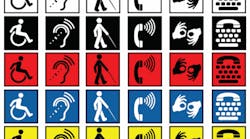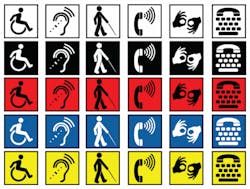by Cathy Hester Seckman, RDH
Most hygienists have favorites among their patients, and even among the parents, children, or caregivers who come along for appointments. My favorite is Sione. When Jennifer brought him along with her to her last appointment, she said, "Sione's retiring next week.""Oh, no!" I said, patting his old, gray head. "I'll miss you, buddy!"
Sione is a service dog. He's been working with Jennifer, who has myasthenia gravis syndrome, ever since I can remember. But he's 10 years old now, and has arthritis, so it's time for him to step aside for a younger dog. He'll spend his retirement years with Jennifer's parents.
You might cringe to think of a hairy, 100-pound black Labrador in a dental office, but dealing with special-needs patients also involves dealing with their caregivers, which includes service animals. Sione has always been a model caregiver. When Jennifer is settled in the dental chair and tells him he's off-duty for a few minutes, he finds a carpeted corner and curls into a tight ball until he's needed again. Most visitors to the office never notice him. Sione is typical of every service dog I've ever met – circumspect, silent, perfectly behaved, and calm.
I can't hold much of a conversation with Sione, of course, but one of his most endearing qualities is his ability to put me at ease, a common trait with caregivers. He makes it easier for me, and for other people, to communicate with Jennifer. He helps us get past our initial uncertainty in order to see the articulate educator and doctoral candidate.
Communicating with special needs patients can be difficult, and often the most difficult problem is our own unease. How well do you handle yourself with special needs patients? Are you nervous? Reluctant? Unsure? Most people are.
At my current office I see more special needs patients in a month than I did in a year at my previous offices because we specialize in pediatrics. We're familiar with all types of handicaps, and we see special needs patients of all ages.
Our patients include Jennifer, who needs help transferring from her wheelchair; 16-year-old Kevin, who has spina bifida and whose mother picks him up with no effort at all; Barbara, who is visually impaired and has mental retardation; Dallas, who has autism and views the world through his video camera; Brandon, who has ADHD and needs frequent wiggle breaks; and Jefferson, who has Down syndrome, loves the Three Stooges, and is 6'3" and weighs 280 lbs. It can be interesting when a 280-pound teenager lumbers into the office shouting, "Nyuk! Nyuk! Nyuk!" and wanting to knuckle us on the head.
Experiences like these have gradually given me enough confidence to see special needs patients without panicking. I've learned that being comfortable with such people boils down to one thing: communication.
Communication is any process that transfers information. Answers.com offers several definitions:
- The exchange of thoughts, messages, or information, as by speech, signals, writing, or behavior
- Interpersonal rapport
- The art and technique of using words effectively to impart information or ideas
When faced with a person who is unlike you, effective communication can take extra effort. Here are some "What if?" questions that lead to ideas for creative communication with all types of special people.
What if a patient is hearing-impaired?
An occasion for panic might be when a hearing-impaired person sits in your chair for the first time. If it's a child you can relax, because he or she will invariably have an interpreter. Just remember to directly address the child, not the interpreter. If the patient is an adult, here are some strategies:
Face the patient squarely, speak slowly, and ask, "Do you read lips?" It's important to realize not every hearing-impaired person has that talent. With those who do, communication is much easier. With those who don't, pantomime and a notepad go a long way toward making a visit comfortable, and even fun. In addition, it isn't difficult to master a few key health care phrases in American Sign Language (ASL).
Educator Elaine Ernst Schneider and nurse Joann Mikola address this exact issue on their Web site, www.lessontutor.com. In their store, you can purchase an inexpensive package of lessons, flash cards, and cheat sheets called "Introducing American Sign Language to Health Care Professionals." The lessons provide descriptions and graphics for common health care questions such as, "What is the problem? Are you sick or hurt? What medication have you taken today?"
What if the patient has mental retardation or Down syndrome?
Jefferson, the Three Stooges fan, makes me nervous because he's so large. If he's in a bad mood, I'm not sure I'll be able to make him do things he doesn't want to do. To control my nerves, I rely on simple, repetitive explanations. "Jeff, you know we have to put fluoride on your teeth today. Your mom wants you to have strong, healthy teeth. Fluoride is like a vitamin, to make them strong. Do you want strong teeth? When you eat corn on the cob, do you want your teeth to be strong? When you smile at your girlfriend, does she want to see strong, healthy teeth?"
The Special Care Dentistry Association at www.scdaonline.org offers suggestions for communicating with those with mild mental retardation:
- Minimize distractions
- Use short explanations
- Use simple language
- Take more time than usual to present information
- Avoid an explanation of causes
- Focus on the effects of lack of oral hygiene
- Teach activities rather than concepts
- Encourage consistency
- Use "tell-show-do"
- Use verbal praise
For those with more severe retardation, explanations and language need to be even more simple and direct.
What if the patient has an autism spectrum disorder?
Communication in these cases needs to start with the patient's caregiver. Suppose that 9-year-old Tyler has autism and has never had a successful dental visit. It's a good idea to meet with Tyler's mom before the appointment. Ask her what you can do to make the first visit easier. Tyler's mom, who knows her child very well, will have plenty of ideas. Autistic children can have sensory modulation disorders that are olfactory, auditory, or visual, or related to movement, proximity, touch, temperature, or taste – all issues closely related to our job.
Together, you and the mother can decide on appropriate strategies for each of the sensory problems. Unflavored prophy paste, paste-free prophy angles, fluoride varnish, earplugs, a headset with Tyler's favorite music, sunglasses, reclining the chair before Tyler sits down, and making slow, deliberate movements can all help make the visit easier. Tyler's first visit can be a no-pressure desensitization session designed to familiarize him with everything that will happen.
An organization called Practice Without Pressure Inc. maintains a Web site at www.pwpde.com to help parents and professionals learn techniques for making health and personal care visits easier for specials needs children and adults. The step-by-step PWP lessons use practice sessions and flash cards to desensitize special needs patients to dentistry, phlebotomy, testing procedures, and even haircuts. The dental visit flash cards are very comprehensive, and include things such as, "The hygienist puts on gloves." The practice sessions include using a paper clip to simulate an injection.
Besides telling the patient what you'll do, it's also good to walk him or her through the procedure in a calm, non-threatening manner. Take everything step-by-step. "Tell" and "show" several times before you attempt to "do."
What if the patient is visually impaired?
Communication is not as difficult in this case, but it's still important to begin each visit by asking, "What can I do to make this easier for you?" One of my patients liked to take my arm as we walked from waiting room to operatory. Another liked to navigate the hallway on her own. Touching the patient's cheek lightly can be a signal to open the mouth. Describing the X-ray equipment can desensitize a nervous child, as well as letting him or her touch and move the equipment. Always give a patient a warning before you move the chair or turn on a noisy piece of equipment. Keep up a constant verbal stream of information so the patient never has to wonder what's coming next.
What if the patient has ADHD?
The Attention Deficit Disorder Association defines ADHD as a three-part problem that involves:
- Distractibility (poor sustained attention to tasks)
- Impulsivity (impaired impulse control and delay of gratification)
- Hyperactivity (excessive activity and physical restlessness)
Communicating with an ADHD patient can be frustrating at best, especially when there is a schedule to keep. Brandon is known in our office as the "wiggle-break kid." He's a nonstop talker and nonstop mover. The best way I've found to handle Brandon is to take his as well as my needs into account. Brandon needs to ask questions. The first few minutes of our appointment are always spent chatting. I answer an endless stream of questions: "What's this thing? What's that thing? Why don't you have a TV here? How long will this take? What did you have for breakfast today? Want to know what I had? Did you know we got a new puppy?"
After a dozen or so questions I tell Brandon he can ask three more, then it'll be time to get started. I hold up a finger for each question, and when I get to three, I pick up a mirror and say, "Open big, Brandon, then we can talk some more after this."
After my initial exam we take time for more conversation. When we finally get down to business, I let him know how long it will be before the first wiggle break, because Brandon not only needs to talk, he needs to move. We both take wiggle breaks, which also turn into giggle breaks, then we get back to work. Oral hygiene instructions are always short and sweet with Brandon, and I ask him to repeat them back to me. As long as I take the time to talk with Brandon and address his particular needs, he always leaves the chair happy.
The next time you find yourself cringing at the thought of the next special needs patient on the schedule, remember that communication geared to each patient's particular needs is the best confidence-builder you can use.
Cathy Hester Seckman, RDH, is a frequent contributor based in Calcutta, Ohio. Besides working in a pediatric dental practice, Seckman is a prolific freelance writer, a book indexer, and a speaker on dental and writing/indexing topics. She can be reached at [email protected].






